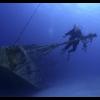As divers we must make decisions about our health when it comes to diving everyday. We choose who we give our business to and if they practice what we feel is an unsafe practice then we can choose to not give them business. OTOH...if we encourage a business to practice unsafe habits then we are guilty as well. But we must know what is fact, fiction, and common beliefs so we can make informed and educated decisions.
I know that I personally thought an 'overfill' or now adays called a 'cave fill' was great. WOW!!! Look how much more gas/air I have and how much safer I'll be with that reserve. Now that I know more about diving I realize that there is a reason that things like 'cave fills' and 'overfills' are a bone of contention. Many see them as harmless and others know in principal that they are harmful. The real trick is to find the appropriate middle ground.
And of course its all clear as mud!
I will say this...I got a 'cave fill' to 3600 psi in a tank last year on our annual Florida trip and it blew an o-ring in my first stage out. It ruined my dive...could have seriously hurt me if it had happened in the water and it almost ruined my second dive of the day. (I had to use borrowed gear which is never a preferred way of diving!) So in my book...serious overfills are not safe and they are not desired. I like my gear just as it is WAY too much to risk losing it over an 'overfill'.
I'd rather carry a bigger tank or a safety stage if I am worried about having enough air/gas to dive with.




















